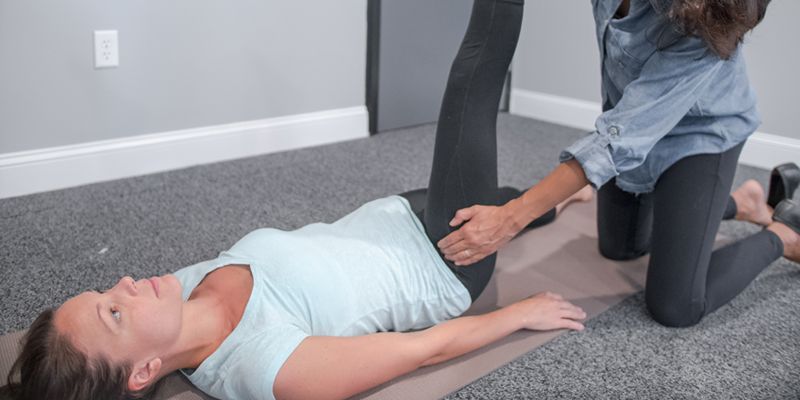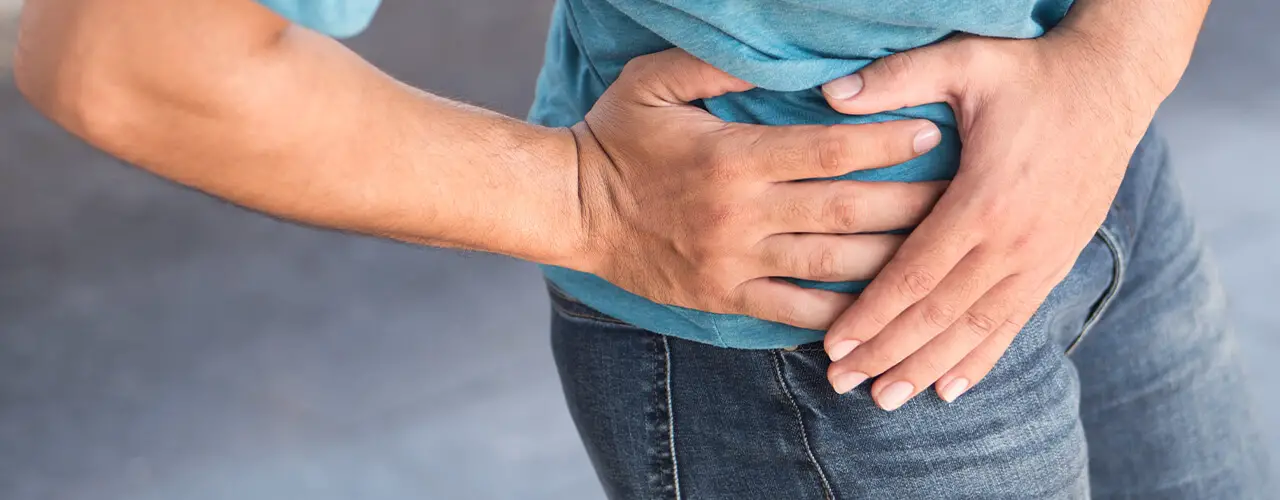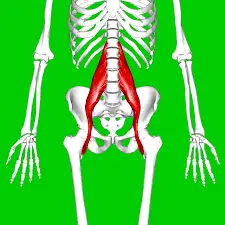Article reviewed and approved by Dr. Ibtissama Boukas, physician specializing in family medicine
When we talk about the psoas, few people think of intestinal disorders. However, this muscle has anatomical and physiological relations with the intestine.
Psoas pain and bowel are therefore connected, and psoas damage can cause symptoms such as stomach ache, bloating, gas, etc. How ? Why ? What could be done to fix it ? This article reviews the relationship between psoas and intestine.
A little anatomy lesson
When you suffer from abdominal pain, nausea or Constipation, you probably think the problem is limited to your digestive system. Certainly, it is true that some viruses or infections contribute to intestinal disorders. However, the origin of the problem can sometimes be related to your psoas muscle in some cases.
To better understand how digestive problems can come from the psoas muscle, it is advisable to review certain anatomical concepts allowing you to better understand the link between your pelvis and certain organs.
Le psoas designates to a muscle group which is located in the posterior part of the abdomen. We often talk about iliopsoas ou iliopsoas.
This group of iliopsoas muscle consists of two muscle heads:
- le iliac muscle which attaches to the pelvic bone (iliac bone);
- le psoas muscle proper which attaches to the front of the vertebrae lumbar (spine).
These two muscular heads meet at the level of a tendon which attaches to the apophysis of the femur (or lesser trochanter). Crossed by the nerve sciatica, psoas has an anatomical connection with the diaphragm, the pelvic area and the intestine.
Psoas muscle, cause of intestinal disorders?
The anatomy of the psoas muscle confirms to us that there is an anatomical proximity between this muscle and certain organs.
A theory commonly conveyed in osteopathy states that the viscera have an influence on the muscle chains. Thus, a visceral disorder could affect the musculoskeletal system by causing mechanical pain.
In the same way, irritation of a muscle could affect the surrounding visceral contents, and cause characteristic symptoms. This is the case, for example, of a psoas tendonitis which could cause digestive symptoms due to its connection with the cecum (part of the intestine).
For example, a hypertensive (thickened) psoas could increase abdominal pressure and affect gut health.
Another theory states that the pain caused by psoas injury may increase overall stress levels. However, it has been proven that stress affects various physiological functions of the gastrointestinal tract (such as gastric secretion, intestinal motility, visceral sensitivity, blood circulation in the mucous membranes, etc.).
This stress would disrupt intestinal health and thus affect digestion. This is especially true for the psoas muscle because its relationship to the diaphragm (via fascia) alters the breathing pattern, which further predisposes to stress.
Finally, you should know that the lymph nodes of the parasympathetic system are located at the cervical and sacral level. As there is an anatomical proximity between the sacrum and the psoas muscle, involvement of the lymph nodes at this level could potentially cause digestive symptoms.
Symptoms of the disease
On the one hand, we know that mechanical damage to the psoas muscle can cause the following symptoms:
- inguinal pain (in the fold of the groin) which can radiate into the leg
- hip weakness and fatigue
- exacerbated pain when climbing stairs
- exacerbated pain on coughing, deep breathing and when sneezing (due to the relationship with the diaphragm)
But the psoas muscle can also cause intestinal disorders. What do we mean exactly? Here is a list of symptoms that can also be observed in the presence of psoas disease:
- Bloating and swollen belly
- Stomach or rib pain
- nausea
- Gas
- acid reflux
- Stomach pains
- Constipation
- Diarrhea
How do you know if the symptoms mentioned above come from the psoas, and not from diseases such as irritable bowel syndrome, Crohn's disease, appendicitis, celiac disease, or other?
On the one hand, these symptoms will be accompanied by mechanical pain. This is usually aggravated by certain movements (such as climbing stairs), and relieved by rest or other positions. at themedical imaging, we will sometimes observe an inflammation at the level of the psoas characteristic of a tendinopathy.
Most often, these digestive disorders will not be relieved by the typically prescribed medications, namely antacids, laxatives, antibiotics, etc. On the contrary, massages or stretches will seem to relieve your symptoms.
Scientific studies
- In a study, compression of the medial border of the ascending colon and displacement of the small intestine at the lumbosacral level were observed in an athlete. This compression was caused by hypertrophy of the psoas muscle (confirmed by computed tomography).
- In other study, psoas abscess has been observed in patients with inflammatory bowel disease (IBD). Although the cases are very rare, and the causative factor has not been demonstrated, it is possible that there is a relationship between psoas irritation and intestinal disorders.
Treatment
If you're feeling nauseous, lost sleep due to an upset stomach, or just can't eat a meal without regretting your food choices, it might be time to take a deeper look. .
Here are some general tips that will allow you to better manage your condition:
- Above all, it must be ensured that the symptoms do not really come from a local attack, from an intestinal disease or even from a more serious attack. A doctor will give you check-ups and examinations, prescribe medication, change your eating habits, will encourage you to drink plenty of water, try a gluten-free diet, lose weight, etc.
- In addition to the conditions mentioned above, make sure that your digestive problems do not come from stress, hormonal changes (related to menstruation for example), a pregnancy, a fibromyalgia, etc.
- If your intestinal problems persist despite everything, ask your doctor to investigate the thoracic region as well as the spine. For example, a medical imaging such as an X-ray, CT scan or MRI could identify dysfunctions in the psoas or spine.
- Get massages from a health professional in the psoas and pelvic region to see if your digestive symptoms are relieved. Also apply heat with a heating pillow (like this one) for 15 minutes a day.
- Body relief: Large 60 x 30 cm electric heat pad, ideal for back, neck, shoulders, abdomen, legs, arms, feet, etc. Relieving all kinds of muscle pain, promoting blood circulation and keeping your body warm are essential for you and your family in winter.
- Powerful setting: The electric heating mat has 6 temperature settings and 4 time settings. You can set the temperature at 104° to 140° F and the time at 30° to 120 minutes. Easy to control to meet your different heat needs.
- The heating mats are CE and ROHS FCC certified and are very safe and energy efficient. The electric blankets feature auto-shutoff and overheat protection and a 4-timer auto-shutoff setting to prevent overheating, ensure safety and save energy.
Last updated on 2024-04-17 / Affiliate links / Images from the Amazon Partners API
- Relax your pelvic and psoas musculature, for example by using a massage gun, massage roller, or acupressure mat.
- MASSAGE GUN DEEP TISSUE - ALDOM muscle massage gun for athletes is ideal for relieving muscle pain, aches and stiffness, promoting blood circulation and helping to speed up warm-up and recovery. It also helps restore the body faster and can be used as your percussion massager at the gym or sports club, is held with one hand and has a comfortable handle.
- 6 MASSAGE HEADS + 30 SPEED - The deep tissue massage gun comes with 6 different massage heads to help relieve sore muscles, 30 adjustable speed modes, Choose the speed and massage heads that best suits your needs. your needs (1 to 800 pulses per minute) to target different body parts and muscle groups, Integrate a percussive massage experience. Reduce muscle recovery time.
- SUPER QUIET AND POWERFUL MASSAGE GUN - Professional handheld percussion massager. Featuring a powerful, high-penetration motor, the deep tissue massager is designed to send waves of relaxation and relief throughout the body, and increase everyday mobility and flexibility with percussive therapy for pain relief joints and muscle pain and prolongs the duration of muscle massage
Last updated on 2024-04-18 / Affiliate links / Images from the Amazon Partners API
- 【6 in 1 Massage Kit】The muscle roller set includes 1*foam roller, 1*massage roller stick, 1*massage ball, 1*resistance band, 1*figure 8 exercise band, 1 * product manual and 1 storage bag. You will treat yourself to a full body massage – from neck to toes. 12 months warranty, so please feel free to contact us if you have any questions, we will do our best to satisfy our customers.
- 【Effective Tension Relief】Use this foam roller set before workout to stretch muscles and prevent muscle injury. You can also activate muscles to enhance exercise effects during exercise. It is also suitable for stretching and balance exercises. Use for 20-30 minutes daily to relieve tight, stiff muscles and relieve tension.
- 【Excellent Elasticity and Durability】The muscle roller set is made of eco-friendly EVA material which has excellent durability, water resistance and elasticity, and is not easily deformed. The foam roller with protrusions is gentle on the body and gives an acupressure feeling. No smell, no harm to the body, no sweat. You can wash it directly with water.
Last updated on 2024-04-17 / Affiliate links / Images from the Amazon Partners API
- 【Multifunctional Physiotherapy】The acupressure kit set includes an acupressure mat and pillow, and 2 massage balls. You can use the acupressure set in different ways and on different parts of the body, such as lower back pain, insomnia, chronic stress, fatigue, tension, circulatory disorders, etc.
- 【Safe and Premium Material】The acupressure mat massager, cushion cover and storage bag are made of 100% cotton, the inside is 21D high-density eco-friendly sponge. The massage nail is made of non-toxic ABS plastic. 100% natural without side effects, hypoallergenic.
- 【Natural Ancient Indian Healing】 The acupressure mat has 230 massage nails, 6210 massage points, the pillow has 73 massage nails, 1971 massage points. Your weight is evenly distributed into thousands of small pieces to stimulate countless acupuncture points. Ideal for relaxation and promoting circulation. The size of the acupressure mat is 68*42cm, the size of the massage pillow is 37 x 15 x 10cm.
Last updated on 2024-04-18 / Affiliate links / Images from the Amazon Partners API
- Do psoas stretches: For more information, see the following article.
- Consult a osteopath. These therapists have a global vision of the human body, and will be able to work the appropriate areas to provide you with relief.
- Some naturopaths will offer natural products which can have a positive effect on your intestinal disorders. However, it is essential to inform your doctor to avoid drug interactions and undesirable side effects.
- If your symptoms are influenced by stress, find strategies to reduce it: diaphragmatic breathing, mindfulness meditation, anti-stress accessories, etc.
What about natural remedies?
Although they are not supported by solid scientific evidence, several natural products and home remedies are used to treat various body pains, especially for their anti-inflammatory power.
Here is a non-exhaustive list of plants and essential oils that are effective in controlling pain and inflammation:
- Turmeric : Thanks to its antioxidant and anti-inflammatory powers very powerful, turmeric is one of the most used plants in a culinary and therapeutic context. The composition of turmeric is essentially made of essential oils, vitamins (B1, B2, B6, C, E, K) and trace elements. But it is to its composition rich in curcumin and curcuminoids that we owe them and calm skin of this spice.
- REASON TO CHOOSE OUR TURMERIC CAPSULES WITH GINGER AND BLACK PEPPER – Our complex turmeric…
- POWERFUL TURMERIC CAPSULES - Turmeric is an excellent source of Vitamin C, antioxidants,…
- IDEAL AND PRACTICAL FORMULA – The powders we use are delicately harvested,…
Last updated on 2024-04-17 / Affiliate links / Images from the Amazon Partners API
- Ginger : In addition to the special flavor it brings to the kitchen and its aphrodisiac properties, ginger is a root well known for its anti-inflammatory powers. THE gingerol gives it its anti-inflammatory action. It is an active component acting on the inflammatory pain related to chronic joint inflammatory diseases, including rheumatoid arthritis, lupus, rheumatic diseases, etc. It has been proven that this active element is also effective in acting on the inflammation linked to arthritis and sciatica. Ginger also has other benefits thanks to its high potassium content and its richness in trace elements (calcium, magnesium, phosphorus, sodium) and vitamins (provitamin and vitamin B9).
- 【Natural Ginger Foot Patches】: Natural Foot Detox Patch with Ginger and…
- 【Ginger Anti Swelling Detox Patch】: Ginger Detox Patches are natural,…
- 【Removes Body Toxins】: Ginger Foot Patches helps reduce the buildup of…
Last updated on 2024-04-17 / Affiliate links / Images from the Amazon Partners API
- Omega-3s : Omega-3 are polyunsaturated fatty acids that play a very important role in the functioning of our body. They are provided by food in three natural forms: docosahexaenoic acid (DHA), alpha linolenic acid (ALA) and eicosapentaenoic acid (EPA). Beyond their action on the brain and the cardiovascular system, omega-3s prove very effective against inflammation. Indeed, they have the ability to act on the inflammatory mechanisms in osteoarthritis by slowing down cartilage destruction, thus they reduce the intensity of osteoarthritis pain. Sciatica, being most often linked to an inflammation secondary to a herniated disc, it can also respond to omega-3 provided it is consumed regularly.
No product found.
- Lemon eucalyptus: Eucalyptus is a plant most often used in the form of herbal tea or essential oil. She would have anti-inflammatory effects which give it the ability to act on the bone and joint pain in general and the pain of sciatica in particular.
- Eucalyptus Citriodora Essential Oil.
- 100% pure.
- Botanical name: eucalyptus citriodo.
Last updated on 2024-04-17 / Affiliate links / Images from the Amazon Partners API
- wintergreen : Wintergreen is a shrub from which a very interesting essential oil is extracted. It is one of the most used essential oils in aromatherapy. This oil extracted from the shrub bearing the same name, is used in massage to relieve sciatica and act like a analgesic. Indeed, it provides a heating effect thanks to its ability toactivate blood circulation locally.
- PROPERTIES ORGANIC WINTERGOOD ESSENTIAL OIL: Wintergreen essential oil is…
- DIRECTIONS FOR USE: Refer to the instructions or ask your pharmacist for advice, This…
- PURESSENTIEL DNA: A range of 55 essential oils essential for well-being in the…
Last updated on 2024-04-17 / Affiliate links / Images from the Amazon Partners API
psoas detox diet
Many patients and athletes turn to diet to speed up their recovery from psoas pain.
Essentially, dietary treatment will consist of prioritizing foods with anti-inflammatory properties, and avoiding foods that may contribute to inflammation.
Which foods to favor exactly?
Although inflammation of the psoas can be treated with medication, there are also several foodstuffs which can help relieve symptoms and promote healing.
These foods are rich in natural anti-inflammatories and can help reduce pain, inflammation and the risk of relapse.
here are some foodstuffs to integrate into your detox diet if you suffer from inflammation of the psoas :
- Fish : Fish is an excellent source of omega-3 fatty acids that help reduce inflammation. The best fish options are salmon, tuna and trout.
- Seafood : Seafood is also rich in omega-3s. The best options are oysters, mussels and crabs.
- Green vegetables : Green vegetables, such as broccoli, collard greens and lettuce, are rich in anti-inflammatory vitamins and minerals.
- Fruits: Fruits, especially citrus fruits, contain high levels of vitamin C, an antioxidant known to reduce inflammation.
- Nut : Nuts, such as almonds, walnuts, and hazelnuts, are rich in vitamins E and B, two vitamins that help reduce inflammation.
By incorporating these foods into your diet, you can relieve the symptoms of inflammation of the psoas and promote healing.
If you suffer from inflammation of the psoas, you should consult a doctor or nutritionist to advise you on the food plan best suited to your case.
What foods to avoid?
Certain foods can make it worse inflammation of the psoas and should therefore be avoided. These foodstuffs are high in saturated and trans fatty acids, added sugars and gluten. Here are some examples of foods to avoid:
- Red meats and charcuterie: Red meat and deli meats are high in saturated fatty acids, which can make inflammation worse.
- Hydrogenated vegetable oils: Hydrogenated vegetable oils are high in trans fatty acids, which can also contribute to inflammation.
- Sugar : Sugar is a stimulant inflammatory. It is present in candies, cookies, and sodas.
- Gluten: Gluten is a protein found in wheat, barley and rye. It may aggravate psoas inflammation in people who suffer from celiac disease or gluten intolerance.
By avoiding these foods, you can reduce inflammation of the psoas and relieve symptoms. If you suffer from inflammation of the psoas, consult a doctor or nutritionist for advice on the best diet diet for you.



















